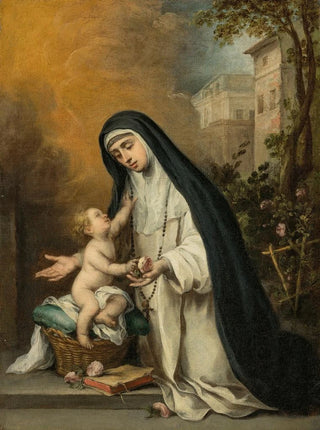Art print | Santa Rosa de Lima - Bartolomé Esteban Murillo


View from behind

Frame (optional)
Reproduction Santa Rosa de Lima - Bartolomé Esteban Murillo – Captivating introduction
The artwork "Santa Rosa de Lima" by Bartolomé Esteban Murillo is a true celebration of spiritual beauty and human delicacy. This painting, imbued with light and softness, transports us to a universe where faith and beauty converge. By depicting the patron saint of Indigenous Americans, Murillo manages to capture the very essence of spirituality and devotion. The art print Santa Rosa de Lima - Bartolomé Esteban Murillo invites you to immerse yourself in a moment of serenity, where every detail is carefully crafted to evoke an atmosphere of peace and contemplation.
Style and uniqueness of the work
Murillo's style is undeniably baroque, but it is distinguished by an intimate approach that gives his characters a palpable humanity. In "Santa Rosa de Lima," the composition is harmonious, with masterful use of light that highlights the angelic face of the saint. The drapery of her clothing, subtly rendered, seems almost alive, adding dynamism to the scene. The color palette, soft and soothing, enhances the impression of tranquility. Murillo excels in depicting emotions, and here, the serenity of Santa Rosa is palpable. Every element of the artwork, from delicate flowers to nuances of light, contributes to creating a sacred atmosphere, conducive to meditation and reflection.
The artist and his influence
Bartolomé Esteban Murillo, born in Seville in 1617, is one of the masters of Spanish baroque. His career, marked by religious commissions, reflects his commitment to spirituality and the representation of Christian values. Murillo was able to combine pictorial technique with a unique sensitivity, influencing not only his contemporaries but also future generations. His style, characterized by gentle traits and luminous colors, paved the way for a new way of perceiving religious painting. By highlighting female figures like Santa Rosa, he contributed to the valorization of the role of saints in art, while infusing a human dimension into sacred stories. The impact of his work continues.

Matte finish

View from behind

Frame (optional)
Reproduction Santa Rosa de Lima - Bartolomé Esteban Murillo – Captivating introduction
The artwork "Santa Rosa de Lima" by Bartolomé Esteban Murillo is a true celebration of spiritual beauty and human delicacy. This painting, imbued with light and softness, transports us to a universe where faith and beauty converge. By depicting the patron saint of Indigenous Americans, Murillo manages to capture the very essence of spirituality and devotion. The art print Santa Rosa de Lima - Bartolomé Esteban Murillo invites you to immerse yourself in a moment of serenity, where every detail is carefully crafted to evoke an atmosphere of peace and contemplation.
Style and uniqueness of the work
Murillo's style is undeniably baroque, but it is distinguished by an intimate approach that gives his characters a palpable humanity. In "Santa Rosa de Lima," the composition is harmonious, with masterful use of light that highlights the angelic face of the saint. The drapery of her clothing, subtly rendered, seems almost alive, adding dynamism to the scene. The color palette, soft and soothing, enhances the impression of tranquility. Murillo excels in depicting emotions, and here, the serenity of Santa Rosa is palpable. Every element of the artwork, from delicate flowers to nuances of light, contributes to creating a sacred atmosphere, conducive to meditation and reflection.
The artist and his influence
Bartolomé Esteban Murillo, born in Seville in 1617, is one of the masters of Spanish baroque. His career, marked by religious commissions, reflects his commitment to spirituality and the representation of Christian values. Murillo was able to combine pictorial technique with a unique sensitivity, influencing not only his contemporaries but also future generations. His style, characterized by gentle traits and luminous colors, paved the way for a new way of perceiving religious painting. By highlighting female figures like Santa Rosa, he contributed to the valorization of the role of saints in art, while infusing a human dimension into sacred stories. The impact of his work continues.






